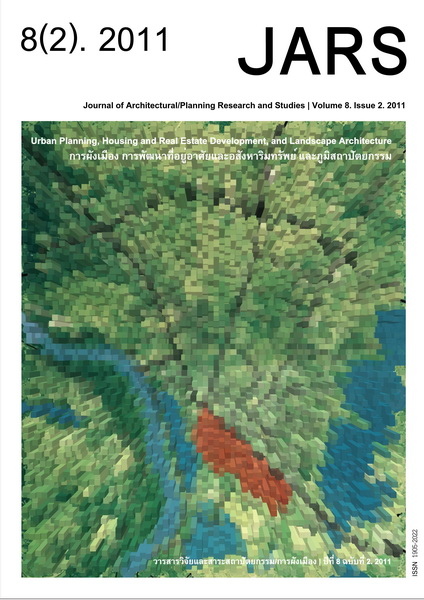A Classification of Risks in Real Estate Development Business
Main Article Content
Abstract
Risks generally denote the negative impact to the real estate project’s progression in regard to these will affect to the construction schedule, project cost and the quality of the products. This article highlights the importance, consequences and impacts of risks in the real estate development projects. This article also classifies risks in the general business, and then focus specifically on those in the real estate business, then it provides the academic and practitioners term of risks as well as define the risks those involve in the real estate business. The risk classifications in this article will be used to support and establish the risk assessment criteria based on the definitions of Social, Technological, Economic, Environmental and Political factors or STEEP factor, which is popularly used in the general and real estate business.
Downloads
Article Details

This work is licensed under a Creative Commons Attribution-NonCommercial-NoDerivatives 4.0 International License.
All material is licensed under the terms of the Creative Commons Attribution 4.0 International (CC-BY-NC-ND 4.0) License, unless otherwise stated. As such, authors are free to share, copy, and redistribute the material in any medium or format. The authors must give appropriate credit, provide a link to the license, and indicate if changes were made. The authors may do so in any reasonable manner, but not in any way that suggests the licensor endorses you or your use. The authors may not use the material for commercial purposes. If the authors remix, transform, or build upon the material, they may not distribute the modified material, unless permission is obtained from JARS. Final, accepted versions of the paper may be posted on third party repositories, provided appropriate acknowledgement to the original source is clearly noted.
References
Brown, R. G., & Matysiak, A. G. (2000). Real estate investment: A capital market approach. Essex, Financial
Times: Prentice Hall.
Chapman, A. (2009). PEST analysis method and examples with free PEST template. Retrieved March 23, 2009,
from http://www.businessballs.com/pestanalysisfreetemplate.htm.
Chen, Z., & Khumpaisal, S. (2008). An analytic network process for risks assessment in sustainable
commercial real estate development. Journal of Property Investment and Finance. Special Issue:
Sustainable Commercial Real Estate.
Crossland, B., et al. (1992). Estimating engineering risk. In Royal Society. London, UK.
Fraser, W. D. (1993). Principles of property investment and pricing (2nd ed.). New York, USA: Palgrave MacMillan.
Gehner, E., Halman, J. I. M., & Jonge H. de. (2006). Risk management in the Dutch real estate development
sector: A survey. Proceedings of the 6th International postgraduate research conference in the built and
human environment (pp. 541-552). University of Salford, UK.
Hargitay, S., & Yu, S. M. (1993). Decision criteria – return and risk, property investment decisions: A quantitative
approach. London, UK: E & FN Spon.
He, Z. (1995). Risk management for overseas construction projects. International Journal of Project Management,
13(4), 231-237.
Huffman, F. E. (2002). Corporate real estate risk management and assessment. Journal of Corporate Real Estate,
5(1), 31-41.
Khumpaisal, S. (2007). Risks in construction project procurement process and risks mitigation methods. Journal
of Architectural/Planning Research and Studies, 5(2), 133-145.
Miller, R., & Lessard, R. D. (2008). Evolving strategy: Risk management and the shaping of mega-projects. In H.
Priemus, B. Flyvbjerg & B. van Wee (Eds.), Decision-making on mega-projects: Cost-benefit analysis,
planning and innovation (pp. 145-172). Cheltenham: Edward Elgar Publishing.
Morrison, L. J. (2007). The STEEP Sectors. Retrieved January 30, 2008, from http://horizon.unc.edu/onramp/
Nezhad, G. H., & Kathawala, Y. (1990). Risk Assessment for International Investment. Management Research
News, 13(1), 1-8.
Pidgeon, N., Hood, C., Jones, D., Turner, B., & Gibson, R. (1992). Risk Perception. In The Royal Society Study
Group, Risk: Analysis, perception and management (pp. 89-134). London, UK: The Royal Soceity.
Project Management Institute (PMI). (2004). A guide to the project management body of knowledge. Charlotte,
NC, USA: Automated Graphic System.
Spaulding, W. C. (2008). Risk. Retrieved March 20, 2009, from http://thismatter.com/money/insurance/risk.htm


